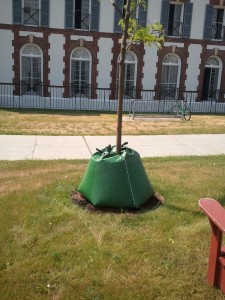The carbon and the oxygen are easy, the plants are getting that in the air we breathe. It’s the Hydrogen that’s been stressing me out lately. Plants obtain it solely from water, through photosynthesis. I always remember my snide remarks in the retail garden center world, when a customer would ask me what kind of fertilizer to buy with their new purchases. For the most part, I’d tell them the single greatest thing they could do would be to water.
How much? It’s a good question with no real definitive answer. I remember from who knows where that gardens in the northeast need about 1/2″ of rain a week in the growing season, and an article on strawberry production I found says about the same (actually .63″). Trees need quite a bit more, though, as they have much more extensive roots throughout the soil horizon. Plan on 2″ of rain a week. I found a handy online calculator to do the math, but here’s a quick answer. A newly planted tree with about a 2″ trunk, should have a 5′ x 5′ zone watered around it, so that’s about 30 gallons, pretending to be a 2″ rain.
Sounds a little high, but the wild and woolly world of plants is never easy. Last year we were averaging 4″ of rain a month, and we didn’t have to do any supplemental watering. On cloudy days plants don’t transpire, or lose water, at as great a clip, so maybe last year it was fine.
Or not. We’re running around like chickens with our heads cut off right now, watering every tree we’ve planted for the last 3 years. (that’s a lot) All of our recently planted trees are showing drought stress, and I’m wondering if I hadn’t watered enough in the last 2 wet years to well establish the trees. When watering, it is best to water a lot all at once, so that the roots have ample moisture and can grow long and deep. Too little water, and the tree keeps its roots near the surface, where the water is, and this makes it less drought resistant in the long run.
We water all trees with 40-50 gallons of water about every 2 weeks. We use two gator bags zipped together, and they drain over the course of about a day. We hand water any tree we missed, and then gator bag it. In this heat and drought, I’d like to water weekly, but I’ve been checking the ground around the trees, and I think we’re keeping up.
Another good trick I learned once when hand watering is to watch the ground as it absorbs water from the hose. I think this is the one of the Eliot Coleman gardening books, but I loaned my copy out and now it’s gone. Once the ground starts to get saturated, the top gets glossy. Take the hose off that spot, and the glossiness will disappear. If you can count to 3 before the glossiness is gone, the ground is moist enough.
identifying drought stress in plants can be tricky, especially in herbaceous plants like annuals and perennials. Woody plants are easier. The inner leaves of the tree turn yellow and fall off. I find this remarkable. It isn’t like trees have brains, but here they are smart enough to drop the inner, less efficient leaves, to conserve its precious water for the maximally producing outer leaves. By the time your plants are showing symptoms of drought, obviously much damage is done. Plants are pretty hardy, so even with serious problems the tree will probably be fine.

